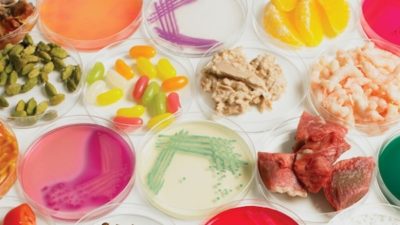2314573 APPL FOOD MICRO

| Course Number | 2314573 | |
|---|---|---|
| Course Credits | 3 (3-0-9) | |
| Course Abbrviation | APPL FOOD MICRO | |
| Course Title (TH) | จุลชีววิทยาทางอาหารประยุกต์ | |
| Course Title (EN) | APPLIED FOOD MICROBIOLOGY | |
| Responsible Unit | Faculty of Science, Department of Food Technology | |
| Type of Course | International Course | |
| Semester | Intl 1st semester | |
| Academic Year | 2024 | |
| Course Coordinator | ||
| Measurement Method | ||
| Type of Course | Semester Course | |
| Course Condition | None | |
| Course Status | Selective course | |
| Instructors / staffs | ||
| Enrollment conditions | None | |
| Degree level | Bachelor | |
| Related curricular | Bachelor of Science in Biotechnology (2562) | |
| Bachelor of Science in Biotechnology (2567) | ||
| Course description (TH) | ศึกษาแนวลึกเกี่ยวกับบทบาทของจุลินทรีย์ในกระบวนการทางอุตสาหกรรมอาหาร และทางเทคโนโลยีชีวภาพ ความสําคัญของจุลินทรีย์ ในเรื่องความปลอดภัยและการ ผลิตอาหาร สถานการณ์ปัจจุบันเกี่ยวกับจุลินทรีย์ก่อโรคอาหารเป็นพิษและ วิธีการ ใหม่ๆที่ใช้ในการตรวจสอบและควบคุม | |
| Course description (EN) | In-depth study of the roles microorganisms play in food industrial and biotechnological processes; importance of microorganisms in the safety and production of foods; current situation on food poisoning microorganisms and new methods of food poisoning/food-borne disease investigation and control. | |
| Curriculum mapping | CU-1.1: Behavioral Objectives Possessing well-rounded knowledge | |
| CU-1.2: Possessing in-depth knowledge | ||
| CU-2.1: Being moral and ethical | ||
| CU-2.2: Having an awareness of etiquette | ||
| CU-3.1: Being able to think critically | ||
| CU-3.2: Being able to think creatively | ||
| CU-3.3: Having skills in problem solving | ||
| CU-4.1: Having professional skills | ||
| CU-4.2: Having communication skills | ||
| CU-4.3: Having skills in information technology | ||
| CU-4.4: Having mathematical and statistical skills | ||
| CU-4.5: Having management skills | ||
| CU-5.1: Having an inquiring mind | ||
| CU-5.2: Knowing how to learn | ||
| CU-5.3: Having leadership qualities | ||
| CU-5.4: Maintaining well-being | ||
| CU-5.5: Being community-minded and possessing social responsibility | ||
| CU-5.6: Sustaining Thainess in a globalized world | ||
| / | subPLO1.1 Explain biotechnology knowledge in practice. | |
| subPLO1.2 Analyze biotechnology knowledge in practice. | ||
| subPLO1.3 Apply biotechnology knowledge in practice. | ||
| / | PLO2 Employ biotechnology-related technology and scientific tools. | |
| PLO3 Communicate effectively in English within the Biotechnology field. | ||
| PLO4 Demonstrate behavior that aligns with ethical principles, moral values, and professional ethics. | ||
| PLO5 Demonstrate social responsibility, courage, and creativity. | ||
| Course learning outcome (CLO) | 1. Describe the roles of microorganisms play in food industries. | |
| 2. Describe the importance of microorganisms in the safety and production of foods. | ||
| 3. Describe the current situation on food poisoning microorganisms. | ||
| 4. Describe the new methods of food poisoning/food-borne disease. |
| # | Date | Time | Learning content | Instructor | CLO | Remark |
|---|---|---|---|---|---|---|
| 1 | Introduction of Food microbiology and Applied Food microbiology | • | ||||
| 2 | Food fermentation and fermentation technology | • | ||||
| 3 | Food fermentation and fermentation technology | |||||
| 4 | Application of Omics technology in food microbiological research | |||||
| 5 | Application of Omics technology in food microbiological research | |||||
| 6 | Application of Omics technology in food microbiological research | |||||
| 7 | Probiotic microorganisms and health benefits | |||||
| 8 | Probiotic microorganisms and health benefits | |||||
| 9 | Control system and standard of microbiological auality in food in industry | |||||
| 10 | Current situation on food poisoning microorganisms | |||||
| 11 | Current situation on food poisoning microorganisms | |||||
| 12 | Control system and standard of microbiological auality in food in industry | |||||
| 13 | Advance and alternative methhods for determination of microorganisms in food | |||||
| 14 | Advance and alternative methhods for determination of microorganisms in food | |||||
| 15 | ||||||
| 16 |
| Teaching/learning media | 1. Transparencies 2. slides 3. handouts | ||||
| Communication channels / LMS | |||||
| Type | Channel identifier / URL | Remarks | |||
| Learning Management System (LMS) | |||||
| Assessment method | Level of assessment | Related CLO | Percentage | ||
| Report | 20 % | ||||
| Mid-term examination | 40 % | ||||
| Final examination | 40 % | ||||
| Grading | Grading System | Letter Grad (A-F) | |||
| Grading method | |||||
| Minimum Passing Level (MPL) | 50 | ||||
| Reading list | |||||
| Type | Title | Remarks | |||
| Textbook | Adams, M.R. and Moss, M.O.(Ed.), Food Microbiology, 2rd ed, The Royal Society of Chemistry, Cambridge CB4WF, UK, 2000. | None | |||
| Course evaluation | Course evaluation system | myCourseVille | |||
| Details of improvement from previous evaluation | – | ||||
| Course quality control | Responses to complaints / petitions from students | Directly to the instructor |
